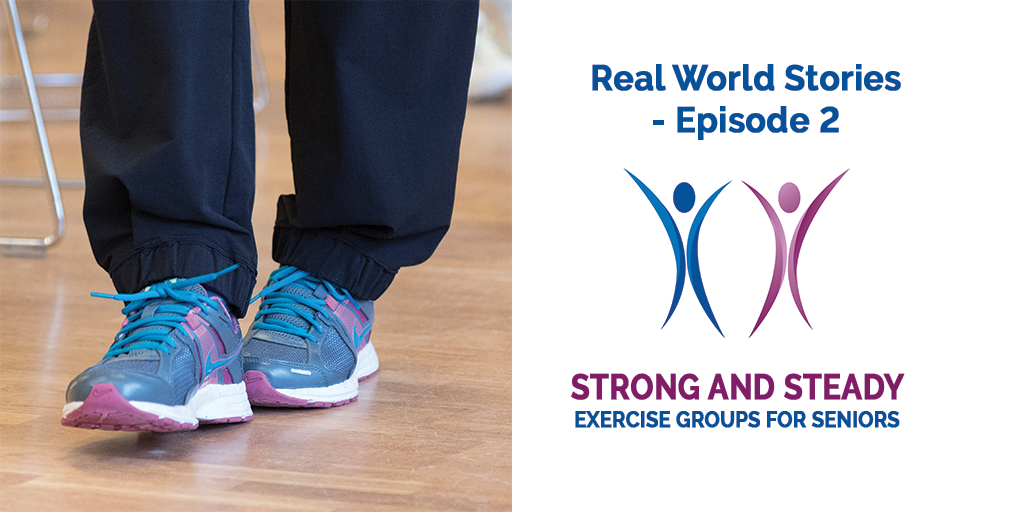The dog’s best friends? Humans. The human’s best friend? Umm well, for many that seems to be the sofa – the buns’ best friend. This soft comfortable piece of fabric, encouraging you to be sedentary week in, week out. It becomes a better and better friend as the years go by, keeping you inactive. But did you know that inactivity is one of the biggest threats to our health and one of the most important risk factors for decreased health and decline in daily physical function in the older population? Being able to function in daily life is a major factor for good health and quality of life. So how can we inspire our seniors to be more physically active, staying fit and healthy?
In Norway, they have an exciting model called “Strong and Steady”, which is low threshold exercise groups for seniors, but with a unique “twist”. The target group is senior people living in their own homes, some of whom have started to feel a bit unsteady and perhaps worried about falling and some are experiencing problems when walking, but they are still able to walk indoors without a walking aid and manage their daily life without much help from the health services or municipality. Research has shown that seniors that start to feel a decline in physical function benefit from an adapted exercise program that increases muscle strength and challenges balance. The exercise program used in Strong and Steady is based on two well-known fall prevention programs developed in New Zealand (the Otago program) and Great Britain (FaME) but is adopted to seniors earlier in the trajectory of functional decline.
One of Strong and Steady’s main goals is to develop a sustainable operating model on a national level. Achieving this depends on the responsibility for coordination, academic updates, and that training of instructors is being taken care of on a national level. The real brilliance about this model is that it is spread not only by training physiotherapists and other professional staff from different Norwegian municipalities, but also by training voluntary instructors. That means seniors are trained to take charge and lead the exercise groups! 
The instructors in Strong and Steady have volunteered because they want to help seniors to improve their physical functioning, and thus get a better life. They have been through both a theoretical and a practical instructor course to gain in-depth knowledge they can use in their exercise groups. Recruiting and educating instructors is a vital part of the Strong and Steady model, which was developed in collaboration with NTNU’s Research group for Geriatrics, Movement, and Stroke (GeMS).
Lise (59) from Bærum, Norway, is one of these wonderful instructors who volunteered. She is an instructor for multiple exercise groups at her local senior’s centre, where the number of participants in the different groups differs from 12 to 24.
“I have previously worked as an instructor in the municipality with “Active in the daytime” for several seasons. [This was an] offer for persons that are on sick leave but wish to get back to working life. That is also the reason why the municipality contacted me about Strong and Steady.”
Lise is living with multiple sclerosis (MS) and is currently not working, but this has not stopped her from volunteering for this greater good.
“I’ve always been passionate about exercising; I’ve taken a lot of instructor courses. To be able to work as a volunteer, like we all do in Strong and Steady, is a great offer and again, with MS, it’s great to exercise myself together with my groups. That’s quality of life!”
And Lise’s passion about exercising has rubbed off on the participants in her exercise groups. She uses exercises that challenge the muscles around all major joints and that provide a sense of accomplishment. Participants have described her exercise groups as great fun with a lot of laughter. One person also said that it is so nice to be there that they cannot skip any of the classes!
Unfortunately, the COVID-19 pandemic has put a lot of restrictions on the community. However, this has not stopped the seniors from continuing their exercises.
“The seniors’ centre is closed at this time. But our participants are motivated through a folder encouraging them to carry out “our” exercises at home, every day!”
Pandemic or not, as our population ages, the number of people experiencing mobility challenges is expected to rise. Strong and Steady is therefore a great initiative that improves mobility and may prevent or reduce mobility loss among seniors. With a snowball effect reverberating throughout the community.
Remember to FOLLOW us on Facebook, Twitter and LinkedIn.
Subscribe to our Newsletter.




